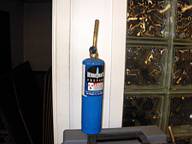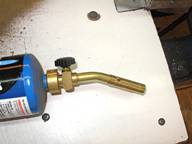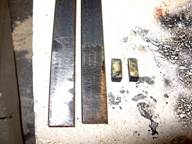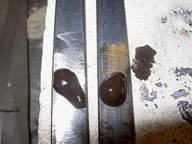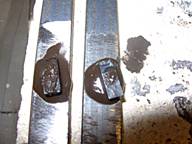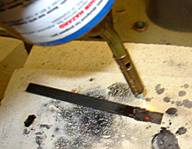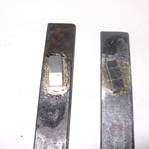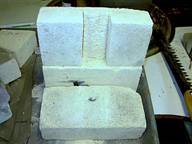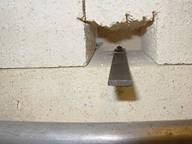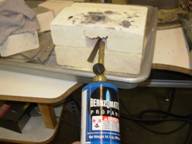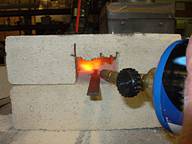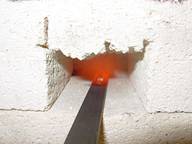Brazing with Propane
Brazing Torch - 1300 F with a Bernzomatic Propane Torch
Here is the answer to whether you can braze with a propane / air torch. You can but you have to control the environment so that the heat loss to the atmosphere and parts is lower than the heat being put into the braze joint.
|
|
|
|
Here is a standard handy torch. (I like Bernzomatic because they have been around forever and have never let me down. Others should work just as well.)
|
|
|
|
Here are two pieces of mild steel 6” x 1/2” x 1/8”. I ground the scale off with a bench grinder to get a clean, rough surface. To the right are two pretinned saw tips from Carbide Processors, Inc. It is a standard braze alloy that melts over a range of 1250 – 1305 F. In the middle is flux on steel and the right picture shows the pretinned tips put on with the braze alloy side down.
|
|
|
I put the steel, flux and tip assembly on a fire brick and heated it. The fire brick is very important since it is a thermal insulator. It does not suck heat away. After about a minute I saw the braze alloy melt and spread. The results are in the right side of the right hand picture.
I cleaned the flux off with a brush and warm water. As a test I grabbed the bar in one hand and the tip with pliers and tried to twist the tip off. The tip is well brazed on. This is almost always a good test. It doesn’t apply much force but a bad braze is very weak and a good braze is very strong so it is a “go / no go” situation.
BEFORE you grab the bar make sure it is cool. They stay hot enough to burn you a long time.
|
|
|
|
You can also build a little oven. It heats faster but it is hard to see when the part is ready. This is how I did the left braze in the picture on the right above. I took three fire bricks (bottom, back and top) and cut a groove in the top one.
|
|
|
|
I put the assembly in and poked the torch in. Everything turned red and it was hard to tell when it was all done. I think this oven method took about half the time of the method above.
In both case the brazing was fast. However they were small parts and they were both insulated from the surrounding air. The part resting on the fire brick was protected plus the fire brick only turned red over an area with a circumference of about one inch so it did nice job of localizing the heat.


